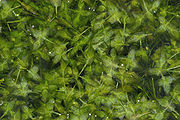
Lemna trisulca
Encyclopedia
Lemna trisulca L. is a species of aquatic plant
s in the genus Lemna
(duckweed) with a subcosmopolitan
distribution, occurring in quiet freshwater
habitats in cool temperate regions. L. trisulca normally doesn't occur in warm temperate regions. Unlike other duckweeds, it has submersed rather than floating fronds, except when flowering or fruiting.

Aquatic plant
Aquatic plants are plants that have adapted to living in aquatic environments. They are also referred to as hydrophytes or aquatic macrophytes. These plants require special adaptations for living submerged in water, or at the water's surface. Aquatic plants can only grow in water or in soil that is...
s in the genus Lemna
Lemna
Lemna is a genus of free-floating aquatic plants from the duckweed family. These rapidly-growing plants have found uses as a model system for studies in community ecology, basic plant biology, in ecotoxicology, in production of biopharmaceuticals, and as a source of animal feeds for agriculture...
(duckweed) with a subcosmopolitan
Cosmopolitan distribution
In biogeography, a taxon is said to have a cosmopolitan distribution if its range extends across all or most of the world in appropriate habitats. For instance, the killer whale has a cosmopolitan distribution, extending over most of the world's oceans. Other examples include humans, the lichen...
distribution, occurring in quiet freshwater
Freshwater
Fresh water is naturally occurring water on the Earth's surface in ice sheets, ice caps, glaciers, bogs, ponds, lakes, rivers and streams, and underground as groundwater in aquifers and underground streams. Fresh water is generally characterized by having low concentrations of dissolved salts and...
habitats in cool temperate regions. L. trisulca normally doesn't occur in warm temperate regions. Unlike other duckweeds, it has submersed rather than floating fronds, except when flowering or fruiting.

External links
- USDA PLANTS Profile
- Lemna trisulca in Flora of North AmericaFlora of North AmericaThe Flora of North America North of Mexico is a multivolume work describing the native plants of North America. These days much of the Flora is available . The work is expected to fill 30 volumes when completed...

